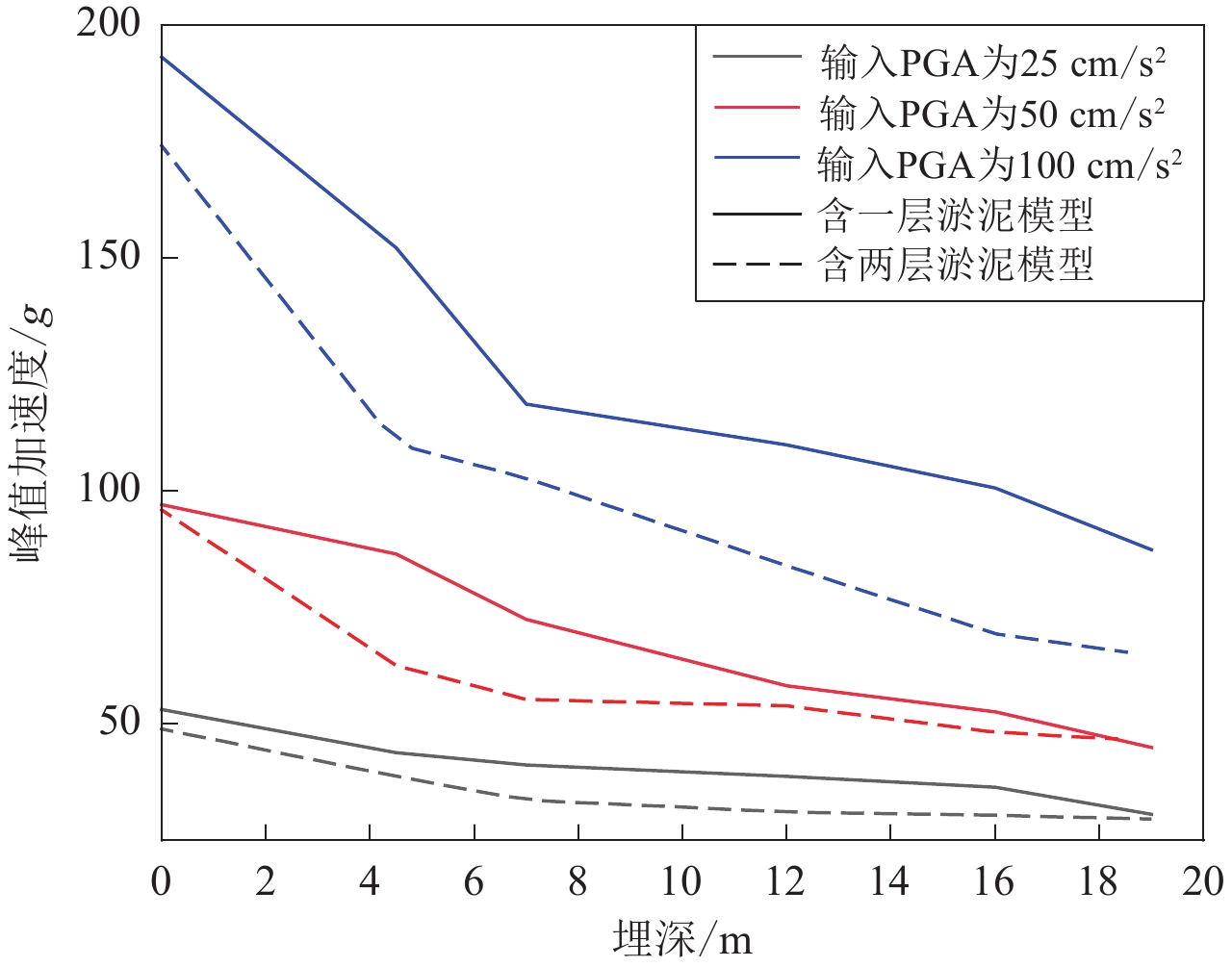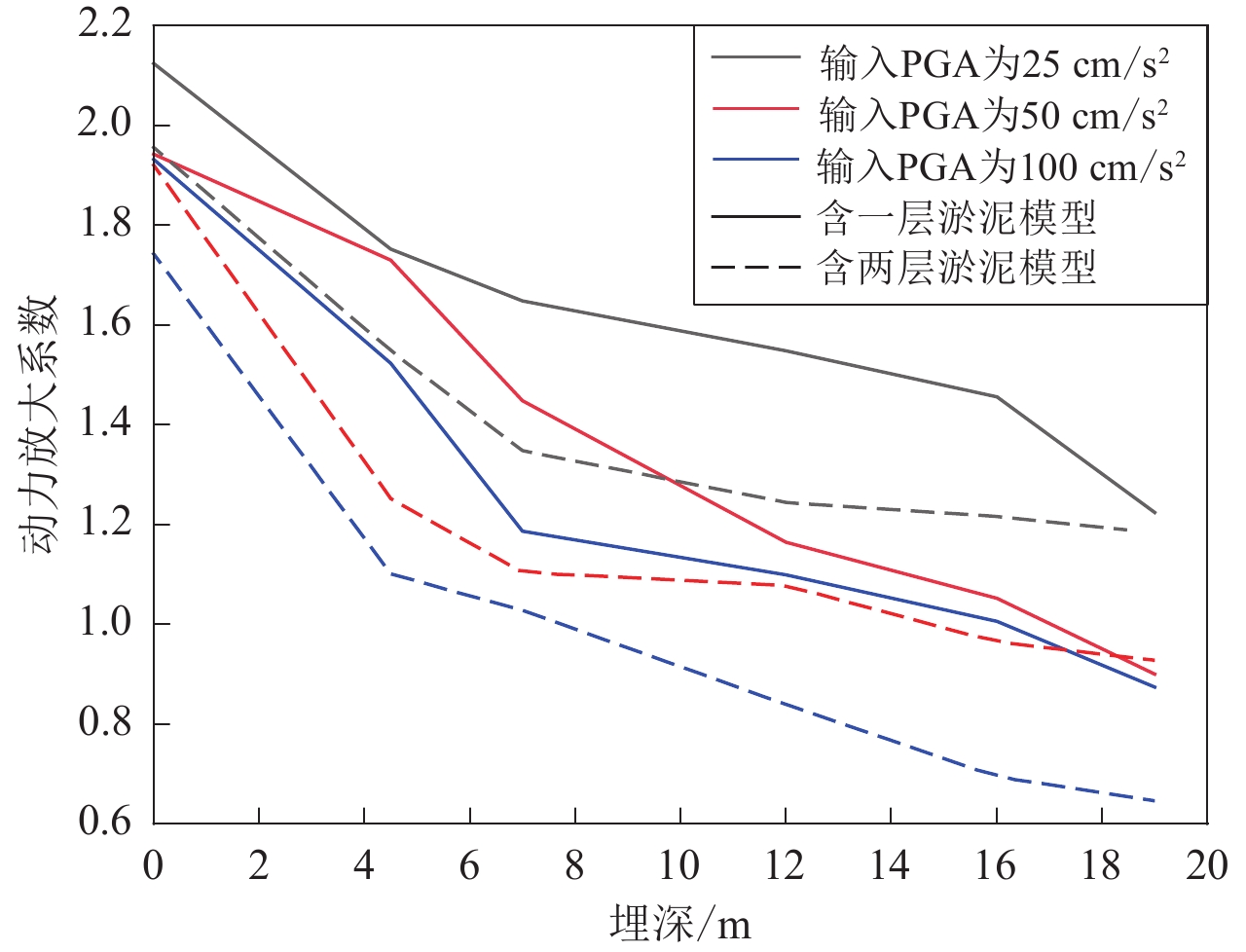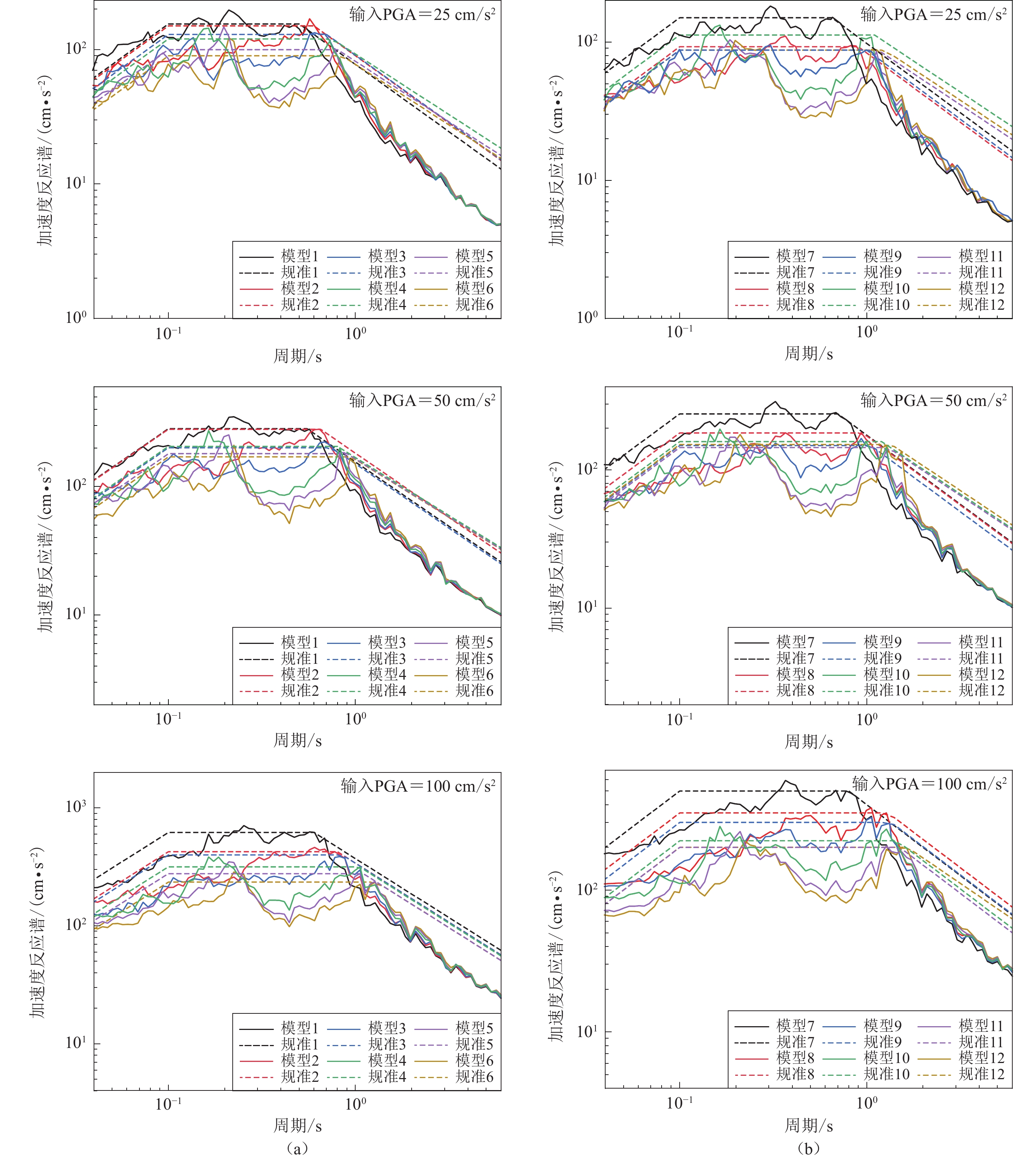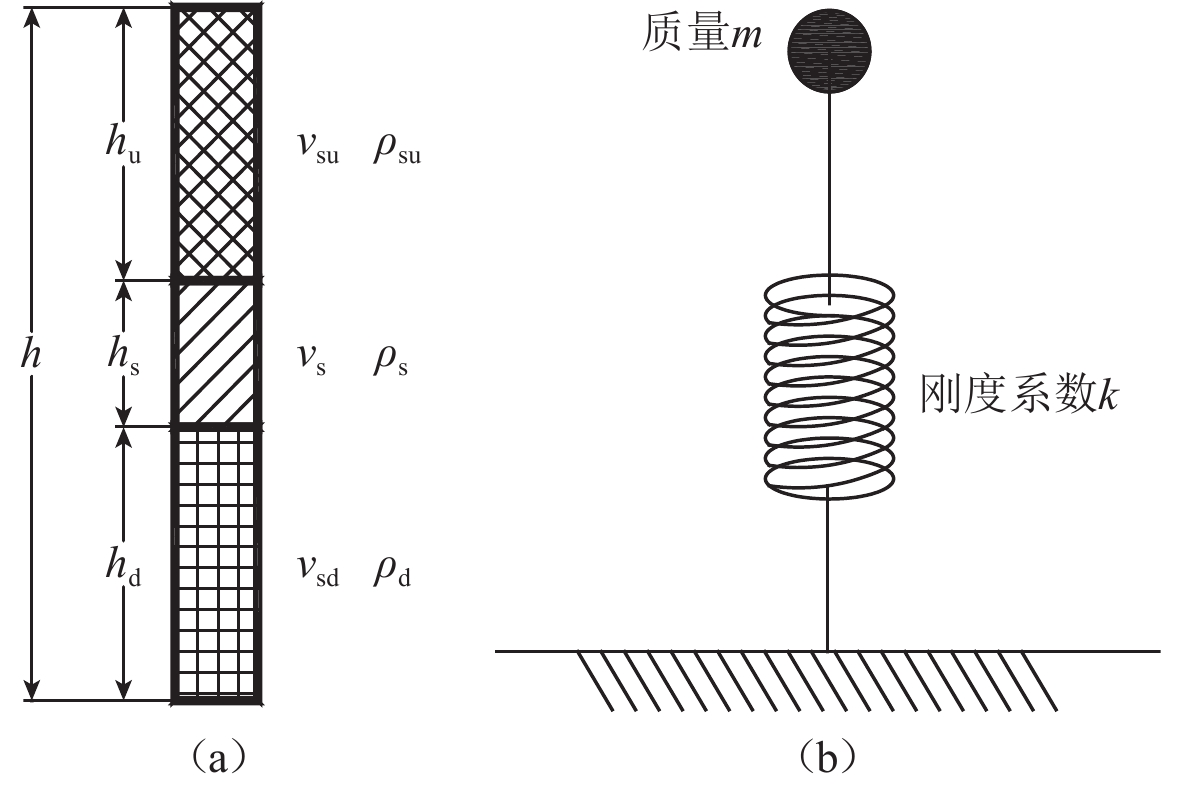An adjustment method for the characteristic period of site acceleration response spectra with soft layers
-
摘要:
在分析场地条件对地震震害影响及国内外关于软弱土层对场地地震反应影响的基础上,采用实际含淤泥质土层场地资料,建立了12个含软弱土层的场地模型,在不同输入地震动水平下进行了场地地震反应一维等效线性化分析,讨论了软弱土层厚度和埋深对场地地震反应的影响。结果表明:随着软弱土层的埋深或厚度的增加,反应谱特征周期逐渐增大;输入地震动峰值增加,反应谱特征周期亦增大。继而依据软弱土层厚度、埋深及输入地震动强度对场地加速度反应谱特征周期的影响特征,提出了含软弱土层场地地震动加速度反应谱特征周期调整方法。
Abstract:In recent years, the impact of soft soil on the seismic response of soil layers in sites has attracted attention. Some scholars have conducted in-depth analysis from different perspectives, and the research results show that soft soil increases the dominant period and response spectrum characteristic period of the site to a certain extent. As the position of the soft interlayer deepens, the amplification effect of the site decreases, and the dominant period and response spectrum characteristic period of the site increase. Compared with the Code for Seismic Design of Buildings (GB 50011−2010) in China, the characteristic period of the seismic acceleration response spectrum for sites containing weak soil layers after regulation is much larger than the value specified in the code. At present, although there is an analysis of the impact of weak soil layers on site seismic response, there is little research on the adjustment methods of characteristic periods of site response spectra containing weak soil layers.Based on the analysis for the effect of site conditions on earthquake damage and the influence of soft layers on site seismic response at home and abroad, 12 site models are established, by means of drilling data from sites containing soft layers. The one-dimensional equivalent linearization site seismic response analysis is carried out under different input acceleration peak, and the influence of soft layer thickness, buried depth and input peak acceleration on site seismic response is discussed. The results show that under the same input acceleration peak, as the burial depth and thickness of soft layer increase, the characteristic period of the site acceleration response spectra gradually increases and the peak ground acceleration decreases. As the input peak acceleration increases, while the thickness and burial depth of the soft layer remain unchanged, the characteristic period of the site acceleration response spectra and the peak ground acceleration increases. Finally an adjustment method for the characteristic period of site acceleration response spectra with soft layers was proposed.
-
引言
场地条件对地震动的影响起决定作用,场地条件主要考虑以下几个方面(薄景山等,2021):近地表的工程地质条件(迟明杰等,2021)、水文地质条件(李伟华,赵成刚,2015)、局部地形效应(王伟等,2016;李平等,2018)及断层场地效应(周正华等,2003)。近地表的工程地质条件可从岩土类型、覆盖层厚度及土层结构等三个方面来考察。一般来说,在相同的地震动作用下,基岩场地上的地震动较小,硬土场地次之,软土场地地震动最大。已有分析表明:土层结构对地震动也具有显著的影响(王海云,2011;李平等,2012),主要表现为:硬夹层(张海等,2016;周正华等,2019,2020; Su et al,2020)埋深增加时,地表峰值加速度(peak ground acceleration,缩写为PGA)、反应谱谱值增大;厚度增加时,地表峰值加速度先逐渐减小、继而逐渐增大,反应谱谱值增大。软夹层(王亚红等,2019)埋深或厚度增加时,地表峰值加速度、反应谱峰值减小。
近年来,含软弱土层的场地对场地地震反应的影响已引起地震工程领域人员的重视,一些学者从不同的角度对其展开了深入的研究。许建聪等(2005)对福州软土场地的地震破坏机理进行了研究,其结果表明,软土在一定程度上增大了场地卓越周期,且卓越周期与地基土的刚度密切相关。Yao等(2022)认为局部软夹层的存在可以显著放大或衰减地震动,从而可能影响空间变化与地震动之间的滞后空间一致性。曹志翔(2006)分析了软夹层埋深对地表地震动的影响,结果表明,随软弱夹层位置的加深,场地的放大作用减小,场地卓越频率减小。王亚红等(2019)通过等效线性方法的场地地震反应分析,研究软夹层埋深对地表地震动参数的影响,结果显示:随着软夹层埋深由浅到深的变化,加速度峰值、速度峰值和反应谱峰值也会随着减小,特征周期和反应谱最大值所对应的周期也会随着软夹层的埋深增加而呈现递增的变化趋势。田守岐(2013)提出了相同Ⅲ类场地条件下,含弱软土层场地的地表地震动参数值与不含软弱土层的场地差异很大,软弱土层在土层结构中的埋深不同,地震动参数值的差异也很大。闫孔明等(2017)重点通过加速度放大效应和地震波波动机制探讨软弱夹层和斜坡效应对斜坡场地动力响应的影响,并结合传统傅里叶谱和希尔伯特(Hilbert)边际谱方法,在频域内展示了场地的频谱变化特性。李美娟和夏雄(2017)针对软土夹层在埋深不变的情况下,计算软夹层厚度分别为3 m,5 m和9 m的三个剖面来分析软土夹层的埋深和厚度对地表地震动参数的影响。王竞等(2022)采用理想场地作为基础研究模型,改变软土层所在位置得到相关计算模型,通过土层反应分析来探究不同位置软夹层对场地地表峰值加速度、放大系数、等效剪切波速计算值的影响,得到了软弱夹层对场地的峰值加速度影响为先放大后缩小、四类场地的传播能力有一定范围、等效剪切波速不能反映土层结构等相关结论。
综上所述,软弱土层对场地地震反应具有显著影响,该影响尤其表现为特征周期显著增大。经规准后的反应谱特征周期与我国GB 50011−2010 《 建筑抗震设计规范 》 (2016版)(中国建筑科学研究院,2016)相比,含软弱土层的场地地震动加速度反应谱特征周期远大于规范规定的取值。目前虽有针对软弱土层对场地地震反应影响的分析,但鲜有关于含软弱土层场地反应谱特征周期的调整方法研究。鉴于此,本文将在前人现有研究基础上,建立含淤泥土层的软弱场地模型,针对软弱土层对场地地震反应的影响进行分析,并提出场地地震动加速度反应谱特征周期的调整方法,以期为含软弱土层场地地震动反应谱特征周期的确定提供理论依据。
1. 地震动输入
含淤泥层的软弱场地地震反应分析中,输入地震动通过人工合成(Thráinsson,Kiremidjian,2002;徐国栋等,2010;刘帅等,2018)得到,峰值加速度分别为50 cm/s2,100 cm/s2和200 cm/s2,时间间隔为0.02 s,离散点数为2 048。对加速度时程幅值缩小50% (25 cm/s2,50 cm/s2,100 cm/s2)作为一维土层地震反应分析模型的计算基底输入地震动。输入地震动加速度时程及加速度反应谱如图1所示,其反应谱特征周期分别为0.30 s,0.35 s,0.40 s。
2. 场地地震反应分析
2.1 场地地震反应计算模型及动力参数的确定
为了分析含软弱土层场地地震反应,依据特定场地工程地震条件勘察资料,分别建立了含一层淤泥不同埋深的六个分析模型和含两层淤泥不同埋深的六个分析模型,以分析软弱土层厚度及埋深对场地地震反应的影响特征。
场地土层地震动反应分析,需要土层剖面的土层分层厚度及土层土体性状描述资料,同时也需要土层中土体的力学特性资料,包括土体的剪切波速值、土体的密度值及土体动力非线性特性参数值。依据实际现场勘查资料及实验数据,并考虑不同淤泥层厚度及不同埋深条件,建立了含一层与两层淤泥且埋深不同的六个分析模型。模型1的剖面与力学特性参数列于表1,模型2—模型6是在模型1的基础上通过改变淤泥层上覆粉质黏土的层数得到的,逐渐将模型1的淤泥层下伏粉质黏土逐层上移至淤泥层以上,如模型2上覆有土类号为3 (周正华等,2019)的一层粉质黏土,模型3上覆有土类号为3,4的两层粉质黏土,模型4上覆有土类号为3,4,5的三层粉质黏土,模型5上覆有土类号为3,4,5,6的四层粉质黏土,模型6上覆有土类号为3,4,5,6和7的五层粉质黏土。模型7的剖面与力学特性参数列于表1,模型8—12是在模型7的基础上亦通过改变淤泥层上覆粉质黏土的层数得到的,即模型8上覆有土类号为3的1层粉质黏土,模型9上覆有土类号为3,4的两层粉质黏土,模型10上覆有土类号为3,4和5的三层粉质黏土,模型11上覆有土类号为3,4,5,6的四层粉质黏土,模型12上覆有土类号为3,4,5,6,7的五层粉质黏土。
表 1 分析模型1和模型7的剖面和力学特性参数Table 1. Profile and mechanical characteristic parameters of Analysis model 1模型 土层
序号岩土名称 土类号 层底深度
/m层厚
/m剪切波速
/(m·s−1)密度
/(kg·m−3)模型1 1 淤泥 1 5.0 5.0 112 1580 2 粉质黏土 3 9.5 4.5 160 1860 3 粉质黏土 4 13.0 3.5 165 1870 4 粉质黏土 5 17.0 4.0 199 1880 5 粉质黏土 6 21.0 4.0 212 1960 6 粉质黏土 7 24.0 3.0 242 1980 7 圆砾 8 27.0 3.0 258 2200 8 全风化安山岩 8 30.0 3.0 393 2250 9 计算基底 9 516 2650 模型7 1 淤泥 1 5.0 5.0 112 1580 2 淤泥 2 10.0 5.0 112 1660 3 粉质黏土 3 14.5 4.5 160 1860 4 粉质黏土 4 18.0 3.5 165 1870 5 粉质黏土 5 22.0 4.0 199 1880 6 粉质黏土 6 26.0 4.0 212 1960 7 粉质黏土 7 29.0 3.0 242 1980 8 圆砾 8 32.0 3.0 258 2200 9 全风化安山岩 8 35.0 3.0 393 2250 10 计算基底 9 516 2650 不同计算场地模型各土层土体动力非线性参数及土体密度值源于实际工程场地地震安全性评价项目的试验结果,其各土层土体动力非线性参数列于表2。
表 2 各土层不同剪应变水平下的动力剪切非线性参数Table 2. Nonlinear parameters of dynamic shear of all soils under different shear strain levels土类号 土层名称 参数 剪应变/(10−4) 0.05 0.1 0.5 1 5 10 50 100 1 淤泥 模量比G/Gmax 0.990 2 0.9808 60.910 5 0.835 8 0.504 5 0.337 4 0.092 3 0.048 3 阻尼比ζ 0.017 3 0.024 4 0.052 5 0.071 1 0.123 6 0.142 9 0.167 2 0.171 2 2 淤泥 模量比G/Gmax 0.991 3 0.982 7 0.918 9 0.850 0 0.531 3 0.361 7 0.101 8 0.053 6 阻尼比ζ 0.008 8 0.013 5 0.035 6 0.052 5 0.107 3 0.130 3 0.161 5 0.166 9 3 粉质黏土 模量比G/Gmax 0.991 8 0.983 8 0.924 1 0.858 8 0.548 9 0.378 3 0.108 5 0.057 3 阻尼比ζ 0.013 8 0.019 9 0.045 9 0.064 1 0.120 1 0.142 8 0.173 5 0.178 8 4 粉质黏土 模量比G/Gmax 0.992 5 0.985 1 0.929 6 0.868 4 0.568 9 0.397 5 0.116 6 0.061 9 阻尼比ζ 0.012 3 0.017 6 0.040 2 0.056 1 0.105 3 0.125 8 0.154 2 0.159 2 5 粉质黏土 模量比G/Gmax 0.993 9 0.987 8 0.941 9 0.890 3 0.618 7 0.447 9 0.139 6 0.075 0 阻尼比ζ 0.015 7 0.021 8 0.046 1 0.062 6 0.113 6 0.135 6 0.167 7 0.173 6 6 粉质黏土 模量比G/Gmax 0.994 3 0.988 7 0.946 0 0.897 5 0.636 5 0.466 8 0.149 0 0.080 5 阻尼比ζ 0.018 1 0.024 9 0.051 2 0.068 8 0.123 4 0.147 3 0.182 7 0.189 4 7 粉质黏土 模量比G/Gmax 0.995 0 0.990 1 0.952 4 0.909 2 0.666 9 0.500 3 0.166 8 0.091 0 阻尼比ζ 0.010 6 0.015 2 0.034 2 0.047 8 0.093 6 0.115 4 0.150 4 0.157 0 8 圆砾及卵石 模量比G/Gmax 0.990 0.970 0.900 0.850 0.700 0.550 0.320 0.200 阻尼比ζ 0.004 0.006 0.019 0.030 0.075 0.090 0.110 0.120 9 基岩 模量比G/Gmax 1.000 1.000 1.000 1.000 1.000 1.000 1.000 1.000 阻尼比ζ 0.004 0.008 0.010 0.015 0.021 0.030 0.036 0.046 2.2 计算结果分析
对各分析模型采用等效线性化方法(高武平等,2012;荣棉水等,2013)进行场地地震反应计算时,分别以三个峰值加速度水平(25 cm/s2,50 cm/s2,100 cm/s2)对应的输入地震动加速度时程作为一维土层反应分析模型的基底入射地震动,通过计算各分析模型进行水平向地震反应,得到各模型地表水平向地震反应的地震动加速度时程和反应谱值。
各分析模型不同地震动作用下地表水平向地震反应峰值加速度及地表水平向地震反应动力放大系数列于表3。由表3可以看出,输入相同峰值加速度,软弱土层厚度越厚,地表峰值加速度越小;软弱土层埋深越深,地表峰值加速度亦越小。由表3还可以看出,输入相同峰值加速度,软弱土层厚度越厚,地表峰值加速度动力放大系数越小;软弱土层埋深越深,地表峰值加速度动力放大系数亦越小,且随埋深增加,动力放大系数衰减变慢;在同一软弱土层厚度和相同埋深条件下,随输入峰值加速度的增加,地表峰值加速度动力放大系数逐渐减小,说明场地土具有显著的非线性。
表 3 各分析模型地表峰值加速度和地震反应动力放大系数Table 3. The peak acceleration and dynamic amplification coefficient for surface seismic response of each analysis model模型 输入不同峰值加速度的地表水平向峰值加速度/(cm·s−2) 模型 输入不同峰值加速度的地表水平向地震反应动力放大系数 PGA=25 cm/s2 PGA=50 cm/s2 PGA=100 cm/s2 PGA=25 cm/s2 PGA=50 cm/s2 PGA=100 cm/s2 模型1 53.1 97.1 193.2 模型1 2.124 1.942 1.932 模型2 43.8 86.5 152.3 模型2 1.752 1.73 1.523 模型3 41.2 72.4 118.7 模型3 1.648 1.448 1.187 模型4 38.7 58.2 109.9 模型4 1.548 1.164 1.099 模型5 36.4 52.6 100.6 模型5 1.456 1.052 1.006 模型6 30.6 45 87.4 模型6 1.224 0.900 0.874 模型7 48.9 96 174.2 模型7 1.956 1.92 1.742 模型8 38.7 62.6 110.1 模型8 1.548 1.252 1.101 模型9 33.7 55.2 102.8 模型9 1.348 1.104 1.028 模型10 31.1 53.9 83.9 模型10 1.244 1.078 0.839 模型11 30.4 48.2 69.4 模型11 1.216 0.964 0.694 模型12 29.6 46.4 64.6 模型12 1.184 0.928 0.646 依据表3给出了地表峰值加速度随软弱土层不同埋深下的变化,如图2所示。同样,依据表3给出了地表峰值加速度动力放大系数随软弱土层不同埋深下的变化,如图3所示。
由图2可以看出:输入地震动水平相同情况下,随软弱土层埋深加大,地表峰值加速度越小,且近地表衰减较快,埋深增加,衰减变慢;输入地震动水平不同时,输入峰值加速度越大,地表峰值加速度衰减越快;不同软弱土层厚度对地表峰值加速度有影响,土层越厚,地表峰值加速度越小,浅地表衰减越快,且随输入地震动峰值加速度增加,差异越明显。
由图3可以看出:输入地震动相同时,随软弱土层埋深加大,地表峰值加速度动力放大系数越小,且近地表衰减较快,随埋深增加,衰减变慢;输入地震动水平不同时,输入峰值加速度越大,动力放大系数衰减越快;不同软弱土层厚度对地表峰值加速度有影响,厚度越厚,动力放大系数越小,浅地表衰减越快,且随输入地震动峰值加速度的增加,差异越明显。
各模型地震反应分析中亦得到了阻尼比5%的场地相关反应谱,如图4所示。
由图4a可以看出:对于含一层淤泥的分析模型,相同输入地震动峰值加速度水平下,在场地相关反应谱起伏变化频带内,总体表现为随软弱土层埋深越深,加速度反应谱值越低,且场地相关反应谱衰减段起始频率越来越低,反应谱优势频带越来越宽;输入地震动峰值加速度不同时,各模型反应谱变化趋势大致一致,但输入峰值加速度越大,反应谱值越大;周期在1 s以上的加速度反应谱,各模型结果基本接近,表明软弱土层埋深对长周期地震动影响较小。
由图4b可以看出:对于含两层淤泥层的计算模型,输入相同地震动峰值加速度,在场地相关反应谱起伏变化频带内,总体表现为随软弱土层埋深加大,加速度反应谱值越低,且场地相关反应谱衰减段起始频率越来越低,反应谱优势频带越来越宽;不同输入地震动峰值加速度水平下,各模型反应谱变化趋势大致一致,但输入峰值加速度越大,反应谱值越大。周期在1 s以上的加速度反应谱,各模型结果基本接近,说明软弱土层埋深对长周期地震动影响较小。
依据工程场地自由地表水平向加速度反应谱,计算得到了阻尼比5%的场地相关归一化反应谱,如图5所示。
由图5a可以看出:对于含一层淤泥层的计算模型,相同输入地震动水平下,场地相关归一化反应谱均随软弱层埋深变化而变化,归一化反应谱起伏变化频带内,总体表现为随软弱土层埋深加大,归一化反应谱值越低,且场地相关归一化反应谱衰减段起始频率越来越低,归一化反应谱优势频带越来越宽;不同输入地震动下,各模型归一化反应谱变化趋势大致一致,但输入峰值加速度越大,归一化反应谱越小;周期在0.1 s及以下时,各模型的归一化反应谱基本接近,说明软弱土层埋深对短周期归一化反应谱影响较小,但在0.1 s以上周期段内,软弱土层埋深对归一化反应谱影响较大,总体表现为,软弱土层埋深越深,归一化反应谱值越大,彼此差异越明显。
对于含两层淤泥层的计算模型(图5b):输入地震动相同时,场地相关归一化反应谱均随软弱层埋深变化而变化,归一化反应谱起伏变化频带内,总体表现为随软弱土层埋深越深,归一化反应谱值越低,且场地相关归一化反应谱衰减段起始频率越来越低,归一化反应谱优势频带越来越宽;不同输入地震动水平下,各模型归一化反应谱变化趋势大致一致,但输入峰值加速度越大,归一化反应谱越小;在0.1 s及以下周期段内,各模型归一化反应谱基本接近,说明软弱土层埋深对短周期的归一化反应谱影响较小,但在0.1 s以上周期段内,软弱土层埋深对归一化反应谱影响较大,总体表现为,软弱土层埋深越深,归一化反应谱值越大,彼此差异越明显。
3. 反应谱特征周期调整方法
根据 《 建筑抗震设计规范 》 (中国建筑科学研究院,2016)的场地类别确定方法划分各分析模型场地类别,结果如表4所示。
表 4 分析模型的场地参数及场地类别Table 4. Site parameters and categories of analysis models分析
模型覆盖层
厚度/m等效剪切
波速/m·s−1场地
类别分析
模型覆盖层
厚度/m等效剪切
波速/m·s−1场地
类别模型1 30 156.0 Ⅱ 模型7 35 134.5 Ⅲ 模型2 30 156.0 Ⅱ 模型8 35 134.5 Ⅲ 模型3 30 156.0 Ⅱ 模型9 35 134.5 Ⅲ 模型4 30 156.0 Ⅱ 模型10 35 142.0 Ⅲ 模型5 30 161.3 Ⅱ 模型11 35 161.3 Ⅱ 模型6 30 182.4 Ⅱ 模型12 35 182.4 Ⅱ 由表4可以看出本文分析模型场地类别为Ⅱ 和 Ⅲ类,结合 《 建筑抗震设计规范 》 表5.1.4-2,若按第三设计地震分组考虑,其场地特征周期为0.45 s (对应于Ⅱ类场地)或0.65 s (对应于Ⅲ类场地)。
根据 《 建筑抗震设计规范 》 规定的规整反应谱格式(中国建筑科学研究院,2016)得到场地规准反应谱,并得到各模型场地地震动加速度反应谱特征周期(图6),如表5所示。
表 5 各分析模型场地规准反应谱特征周期TgTable 5. The characteristic periodic values of site standard response spectrum of each analysis model模型 输入不同峰值加速度各模型的反应谱特征周期 模型 输入不同峰值加速度各模型的反应谱特征周期 PGA=25 cm/s2 PGA=50 cm/s2 PGA=100 cm/s2 PGA=25 cm/s PGA=50 cm/s2 PGA=100 cm/s2 模型1 0.5 0.55 0.6 模型7 0.7 0.75 0.95 模型2 0.6 0.65 0.8 模型8 0.9 0.95 1.2 模型3 0.7 0.75 0.85 模型9 1 1.05 1.35 模型4 0.75 0.8 1.05 模型10 1.1 1.2 1.45 模型5 0.8 0.9 1.1 模型11 1.15 1.3 1.5 模型6 0.85 0.95 1.2 模型12 1.25 1.35 1.65 ![]() 图 9 不同输入地震动下补充模型1、2与分析模型2场地相关加速度反应谱(a) 输入PGA=25 cm/s2;(b) 输入PGA=50 cm/s2;(c) 输入PGA=100 cm/s2Figure 9. The site-related acceleration response spectra of supplementary model 1,2 and analysis model 2 under different input ground motions(a) Input PGA=25 cm/s2;(b) Input PGA=50 cm/s2;(c) Input PGA=100 cm/s2
图 9 不同输入地震动下补充模型1、2与分析模型2场地相关加速度反应谱(a) 输入PGA=25 cm/s2;(b) 输入PGA=50 cm/s2;(c) 输入PGA=100 cm/s2Figure 9. The site-related acceleration response spectra of supplementary model 1,2 and analysis model 2 under different input ground motions(a) Input PGA=25 cm/s2;(b) Input PGA=50 cm/s2;(c) Input PGA=100 cm/s2由图6和表5可知:相同输入峰值加速度水平下,软弱土层厚度越厚,场地反应谱特征周期越大;软弱土层埋深越深,反应谱特征周期亦越大,且随埋深增加,反应谱特征周期增幅逐渐变慢,浅地表增幅较快;同一软弱土层厚度和相同埋深条件下,随输入峰值加速度的增加,反应谱特征周期逐渐增大。
为了进一步分析输入峰值加速度水平对含软弱土层场地地震反应的影响,在进行模型1—6的一维场地地震反应分析时,还计算了对应峰值加速度为25 cm/s2地震动时程调幅至50 cm/s2,100 cm/s2,150 cm/s2,200 cm/s2,300 cm/s2输入下的地震反应,其场地相关加速度反应谱见图7。在此基础上,按照前述方法对计算得到的场地相关加速度反应谱规准化,得到了规准反应谱和相关参数,规准谱见图7,规准谱特征周期见表6。
表 6 输入不同地震动水平下模型1—6的反应谱特征周期TgTable 6. Characteristic periods Tg of model 1−6 under different input ground motion分析模型 不同地震动输入水平下的反应谱特征周期 PGA=25 cm/s2 PGA=50 cm/s2 PGA=100 cm/s2 PGA=150 cm/s2 PGA=200 cm/s2 PGA=300 cm/s2 模型1 0.50 0.55 0.60 0.65 0.70 0.75 模型2 0.60 0.65 0.70 0.75 0.80 0.90 模型3 0.70 0.75 0.80 0.85 0.90 0.95 模型4 0.75 0.80 0.85 0.90 0.95 1.00 模型5 0.80 0.85 0.90 0.95 1.00 1.05 模型6 0.85 0.90 0.95 1.00 1.05 1.20 注:输入峰值加速度25 cm/s2的各模型特征周期来自于表5 由图7和表6可知,在不同输入地震动水平下,随输入地震动水平不断增加,各分析模型反应谱特征周期不断增大,例如:模型1反应谱特征周期从0.50 s逐渐增大到0.75 s,模型2从0.6 s增大到0.9 s,模型3从0.7 s增大到0.95 s,模型4从0.75 s增大到1.0 s,模型5从0.8 s增大到1.05 s,模型6从0.85 s增大到1.2 s。
综上所述,软弱土层对场地加速度反应谱特征周期具有显著影响,经规准后的反应谱特征周期与我国抗震设计规范(中国建筑科学研究院,2016)相比,含软弱土层的场地反应谱特征周期远大于规范取值。本文将以建立的12个场地模型为分析模型,依据软弱土层厚度和埋深对场地加速度反应谱特征周期的影响特征,提出含软弱土层场地加速度反应谱特征周期调整方法,以期为含软弱土层场地地震反应谱特征周期的确定提供理论依据。
从含软弱土层场地取高为h的单位面积土柱(如图8所示),鉴于软弱土层刚度相对于其上覆及下伏土层较低,土柱表面的变形可视为由土柱中的软弱层决定,而忽略上、下部分土体变形。基于这一假定,土柱可简化为如图8所示的弹簧−质量单自由度体系,则这一体系的刚度k和质量m为
![]() 图 8 弹簧−质量单自由度体系分析示意图图中h,v和ρ分别表示土层厚度、剪切波速、密度;下标su,s,sd分别表示上覆土层、软弱夹层、下伏土层Figure 8. Schematic diagram of spring mass single degree of freedom system analysisIn the figure,h,v and ρ respectively represent soil layer thickness,shear wave velocity, and density;subscriptsu,s and sd represent the overlying soil layer,weak interlayer,and underlying soil layer respectively
图 8 弹簧−质量单自由度体系分析示意图图中h,v和ρ分别表示土层厚度、剪切波速、密度;下标su,s,sd分别表示上覆土层、软弱夹层、下伏土层Figure 8. Schematic diagram of spring mass single degree of freedom system analysisIn the figure,h,v and ρ respectively represent soil layer thickness,shear wave velocity, and density;subscriptsu,s and sd represent the overlying soil layer,weak interlayer,and underlying soil layer respectively$$ k=\frac{{\rho }_{\mathrm{s}}\times {v }_{\mathrm{s}}^{2}}{{h}_{\mathrm{s}}} \text{,} $$ (1) $$ m={h}_{\mathrm{s}}{\rho }_{\mathrm{s}} + {h}_{\mathrm{u}}{\rho }_{\mathrm{u}} \text{,} $$ (2) 式中:ρs,νs和hs分别为软弱土层的密度、剪切波速、厚度;ρu和hu分别为上覆土层密度与厚度。
不难得到这一弹簧−质量单自由度体系的固有周期为:
$$ {T}_{0}=2 \text{π} \sqrt{\frac{{m}}{{k}}} .$$ (3) 结合式(1)—(3)可看出,随软弱土层厚度或上覆土层厚度的增加,弹簧−质量单自由度体系的刚度减小、质量增加,体系的固有周期变大。如此势必影响场地地震反应的频谱特征,继而使场地地震反应的特征周期增大。因此随地震动输入强度的增加,含软弱土层场地特征周期也增加。输入地震动强度越大,浅地表软弱土层应变水平越高,软弱土体非线性越强,其剪切模量比衰减越快,值越小,继而造成剪切模量降低,以致软弱土层剪切刚度越小,如图8所示的弹簧−质量单自由度体系固有周期变大,从而引起含软弱土层场地的特征周期变大。这一定性解释亦适用于上覆土层、软弱夹层和下伏土层的剪切波速(vsu,vs,vsd)差异不是很大的情形下,通常含软弱土层场地地震反应分析结果表明,应变最大值发生在软弱土层中,且软弱土体的剪切模量比衰减较快,由此导致了软弱土层的剪切模量比小于上覆与下伏土层,从而使三者的剪切模量差异变大,且随输入地震动强度的增加,其差异会更显著,使上述假设基本成立。
为了进一步说明三个土层间波速差异不是很大时的合理性,在原模型2 (见表7)的基础上,将淤泥层分别用上覆和下伏粉质黏土替换,构建了两个分析模型(见表8,表9),并计算得到了相应的加速度反应谱,如图9所示。
表 7 原分析模型剖面和力学特性参数Table 7. The original analysis model序号 土层名称 土类号 层底深度
/m层厚
/m剪切波速
/(m·s−1)密度
/(kg·m−3)1 粉质黏土 3 4.5 4.5 160 1860 2 淤泥 1 9.5 5.0 112 1580 3 粉质黏土 4 13.0 3.5 165 1870 4 粉质黏土 5 17.0 4.0 199 1880 5 粉质黏土 6 21.0 4.0 212 1960 6 粉质黏土 7 24.0 3.0 242 1980 7 圆砾 8 27.0 3.0 258 2200 8 全风化安山岩 8 30.0 3.0 393 2250 9 计算基底 9 516 2650 表 8 补充分析模型1Table 8. The supplementary analysis model 1土层序号 土层名称 土类号 层底深度
/m层厚
/m剪切波速
/(m·s−1)密度
/(kg·m−3)1 粉质黏土 3 4.5 4.5 160 1860 2 粉质黏土 3 9.5 5.0 160 1860 3 粉质黏土 4 13.0 3.5 165 1870 4 粉质黏土 5 17.0 4.0 199 1880 5 粉质黏土 6 21.0 4.0 212 1960 6 粉质黏土 7 24.0 3.0 242 1980 7 圆砾 8 27.0 3.0 258 2200 8 全风化安山岩 8 30.0 3.0 393 2250 9 计算基底 9 516 2650 表 9 补充分析模型2Table 9. The supplementary analysis model 2土层序号 土层名称 土类号 层底深度
/m层厚
/m剪切波速
/(m·s−1)密度
/(kg·m−3)1 粉质黏土 3 4.5 4.5 160 1860 2 粉质黏土 4 9.5 5.0 165 1870 3 粉质黏土 4 13.0 3.5 165 1870 4 粉质黏土 5 17.0 4.0 199 1880 5 粉质黏土 6 21.0 4.0 212 1960 6 粉质黏土 7 24.0 3.0 242 1980 7 圆砾 8 27.0 3.0 258 2200 8 全风化安山岩 8 30.0 3.0 393 2250 9 计算基底 9 516 2650 由图9可以看出,在淤泥层波速与上下土层波速差异不明显的情况下,反应谱特征周期具有明显的差异,且随输入地震动强度增加,差异越明显。
上述给出了含软弱土层使场地地震反应特征周期变大的定性解释,为了进一步定量刻画软弱土层厚度及埋深对场地特征周期的影响特征,基于上述各模型分析数据,通过统计回归方法,得到含软弱土层厚度及埋深对场地特征周期的影响规律,同时也取得了输入地震动强度对含软弱土层场地特征周期的影响规律。
由上述定性分析可知,对于特定的含软弱土层场地,其特征周期与场地卓越周期是相关的,为此假定含软弱土层场地特征周期Tg由软土层的固有周期T0、输入地震动特征周期$ {T'_{\mathrm{g}} }$、下伏土体卓越周期T确定,即
$$ {T_{\mathrm{g}}} = a {T_0} + {T'_{\mathrm{g}}} +b T \text{,} $$ (4) 式中,假设$ T ={{4{h_{\mathrm{d}}}}}/{{{v _{{\mathrm{sd}}}}}} $,而${v _{{\mathrm{Sd}}}} $为软弱土层下土体等效剪切波速,hd为软弱土层下伏土体厚度;a和b为回归系数。
由式(4)可知,场地特征周期考虑了输入地震动频谱特性、软弱土层上下伏土体和软弱土层的影响。以表5和表6的数据为基础,通过最小二乘法(高秋英等,2021)回归得到了式(4)中的回归系数a和b (表10),回归结果如图10所示。
表 10 不同输入地震动水平下场地反应谱特征周期拟合结果Table 10. Fitting results of characteristic period of site response spectrum under different input ground motions输入地震动/(cm·s−2) 模型1—6 输入地震动/(cm·s−2) 模型7—12 a b R2 a b R2 25 0.838 −0.066 0.999 80 25 0.972 −0.297 0.999 12 50 0.941 −0.166 0.999 05 50 1.050 −0.410 0.999 64 100 1.231 −0.270 0.999 72 100 1.246 −0.223 0.999 38 ![]() 图 10 不同输入地震动下含一层 (a) 和含两层 (b) 淤泥的各分析模型场地反应谱特征周期随软弱土层厚度及埋深的变化关系Figure 10. Variation of the characteristic period of the site response spectrum with the thickness and burial depth of the weak soil layer for the analysis models with one-layer (a) and two-layer (b) silt under different input ground motions
图 10 不同输入地震动下含一层 (a) 和含两层 (b) 淤泥的各分析模型场地反应谱特征周期随软弱土层厚度及埋深的变化关系Figure 10. Variation of the characteristic period of the site response spectrum with the thickness and burial depth of the weak soil layer for the analysis models with one-layer (a) and two-layer (b) silt under different input ground motions在统计学中对变量进行线行回归分析,采用最小二乘法进行参数估计时,R2为回归平方和与总离差平方和的比值,表示总离差平方和中可以由回归平方和解释的比例,这一比例越大,模型越精确,回归效果越显著。R2介于0−1之间,越接近1,回归拟合效果越好,一般认为超过0.8的模型拟合优度比较高。在不同输入地震动水平下,软弱土层厚度相同情况下,含软弱土层场地特征周期,随软弱土层埋深的统计关系R2约为1,表明在不同输入地震动水平下,场地地震动加速度反应谱特征周期与软弱土层埋深的相关性较好。模型1—6在不同输入地震动水平下场地地震动加速度反应谱特征周期随软弱土层埋深的变化曲线近似于直线,模型7—12在不同输入地震动水平下场地反应谱特征周期随软弱土层埋深的变化曲线较模型1—6的曲线曲率大,且软弱土层厚度越厚,其固有周期对场地地震动加速度反应谱特征周期的贡献值越大。
此外,依据表6的数据得到了含特定厚度和埋深软弱土层场地的反应谱特征周期Tg与输入地震动峰值加速度A的变化趋势,如图11中的散点所示。由该图可看出,不同模型场地加速度反应谱特征周期Tg随输入峰值加速度增加的变化特征基本相近,且与输入峰值加速度A近似成线性关系。因此,拟通过式Tg=α + βA来拟合场地地震动加速度反应谱特征周期Tg随输入峰值加速度A的变化规律。基于最小二乘法线性回归得到了式中回归系数α和β,如表11所示,回归结果如图11中直线所示。
表 11 不同输入水平下模型1−模型6的反应谱特征周期拟合结果Table 11. Fitting results of characteristic periods of model 1−6 at different input ground motions分析模型 α β R2 模型1 0.501 5 0.000 9 0.962 4 模型2 0.588 4 0.001 0 0.993 7 模型3 0.701 5 0.000 9 0.962 4 模型4 0.751 5 0.000 9 0.962 4 模型5 0.801 5 0.000 9 0.962 4 模型6 0.825 4 0.001 2 0.995 3 回归分析结果R2均接近1,表明场地地震动加速度反应谱特征周期与不同输入地震动峰值加速度具有较好的相关性,对于含特定厚度和埋深软土层场地的反应谱特征周期随输入峰值加速度大致呈线性增长,表明输入地震动峰值加速度越大,场地地震动加速度反应谱特征周期越长。
通过考虑土层结构对场地地震动加速度反应谱特征周期的影响,提出对含软弱土层的场地地震动加速度反应谱特征周期的调整公式,该公式形式简单,物理意义明确,不仅考虑软弱土层厚度与埋深的影响,还考虑了输入不同地震动的影响。利用典型土层结构场地模型进行场地地震反应分析,结果表明,该调整方法不仅合理反映了软弱土层在剖面中的埋深对场地地震动加速度反应谱特征周期的影响规律,且估计值近似等于实际工程场地反应谱特征周期。
4. 讨论与结论
基于建立的12个含软弱土层的场地模型,在不同输入地震动水平下,进行了一维等效线性化场地地震反应分析,讨论了软弱土层厚度和埋深,以及输入地震动强度对场地地震反应的影响及对场地地震动加速度反应谱特征周期的影响特征,提出了含软弱土层场地地震动加速度反应谱特征周期调整方法,获得的主要结论如下:
1) 相同输入地震动水平下,随软弱土层埋深越深,地表峰值加速度越小,且近地表衰减较快,埋深增加,衰减变慢;不同输入地震动水平下,输入峰值加速度越大,地表峰值加速度衰减越快;不同软弱土层厚度对地表峰值加速度亦有影响,厚度越厚,地表峰值加速度越小,浅地表衰减越快,且随输入地震动峰值加速度增加,差异越明显。
2) 相同输入地震动水平下,随软弱土层埋深越深,地表峰值加速度动力放大系数越小,且近地表衰减较快,随埋深增加,衰减变慢;不同输入地震动水平下,输入峰值加速度越大,动力放大系数衰减越快;软弱土层厚度对地表峰值加速度有影响,土层越厚,动力放大系数越小,浅地表衰减越快,且随输入地震动峰值加速度的增加,差异越明显。
3) 随软弱土层的埋深或厚度增加,场地地震动加速度反应谱特征周期逐渐增大;输入地震动峰值增加,场地地震动加速度反应谱特征周期亦增大。继而,根据分析软弱土层厚度、埋深,以及输入地震动强度对场地地震动加速度反应谱特征周期的影响特征,提出了含软弱土层场地地震动加速度反应谱特征周期调整方法。
-
图 9 不同输入地震动下补充模型1、2与分析模型2场地相关加速度反应谱
(a) 输入PGA=25 cm/s2;(b) 输入PGA=50 cm/s2;(c) 输入PGA=100 cm/s2
Figure 9. The site-related acceleration response spectra of supplementary model 1,2 and analysis model 2 under different input ground motions
(a) Input PGA=25 cm/s2;(b) Input PGA=50 cm/s2;(c) Input PGA=100 cm/s2
图 8 弹簧−质量单自由度体系分析示意图
图中h,v和ρ分别表示土层厚度、剪切波速、密度;下标su,s,sd分别表示上覆土层、软弱夹层、下伏土层
Figure 8. Schematic diagram of spring mass single degree of freedom system analysis
In the figure,h,v and ρ respectively represent soil layer thickness,shear wave velocity, and density;subscriptsu,s and sd represent the overlying soil layer,weak interlayer,and underlying soil layer respectively
图 10 不同输入地震动下含一层 (a) 和含两层 (b) 淤泥的各分析模型场地反应谱特征周期随软弱土层厚度及埋深的变化关系
Figure 10. Variation of the characteristic period of the site response spectrum with the thickness and burial depth of the weak soil layer for the analysis models with one-layer (a) and two-layer (b) silt under different input ground motions
表 1 分析模型1和模型7的剖面和力学特性参数
Table 1 Profile and mechanical characteristic parameters of Analysis model 1
模型 土层
序号岩土名称 土类号 层底深度
/m层厚
/m剪切波速
/(m·s−1)密度
/(kg·m−3)模型1 1 淤泥 1 5.0 5.0 112 1580 2 粉质黏土 3 9.5 4.5 160 1860 3 粉质黏土 4 13.0 3.5 165 1870 4 粉质黏土 5 17.0 4.0 199 1880 5 粉质黏土 6 21.0 4.0 212 1960 6 粉质黏土 7 24.0 3.0 242 1980 7 圆砾 8 27.0 3.0 258 2200 8 全风化安山岩 8 30.0 3.0 393 2250 9 计算基底 9 516 2650 模型7 1 淤泥 1 5.0 5.0 112 1580 2 淤泥 2 10.0 5.0 112 1660 3 粉质黏土 3 14.5 4.5 160 1860 4 粉质黏土 4 18.0 3.5 165 1870 5 粉质黏土 5 22.0 4.0 199 1880 6 粉质黏土 6 26.0 4.0 212 1960 7 粉质黏土 7 29.0 3.0 242 1980 8 圆砾 8 32.0 3.0 258 2200 9 全风化安山岩 8 35.0 3.0 393 2250 10 计算基底 9 516 2650 表 2 各土层不同剪应变水平下的动力剪切非线性参数
Table 2 Nonlinear parameters of dynamic shear of all soils under different shear strain levels
土类号 土层名称 参数 剪应变/(10−4) 0.05 0.1 0.5 1 5 10 50 100 1 淤泥 模量比G/Gmax 0.990 2 0.9808 60.910 5 0.835 8 0.504 5 0.337 4 0.092 3 0.048 3 阻尼比ζ 0.017 3 0.024 4 0.052 5 0.071 1 0.123 6 0.142 9 0.167 2 0.171 2 2 淤泥 模量比G/Gmax 0.991 3 0.982 7 0.918 9 0.850 0 0.531 3 0.361 7 0.101 8 0.053 6 阻尼比ζ 0.008 8 0.013 5 0.035 6 0.052 5 0.107 3 0.130 3 0.161 5 0.166 9 3 粉质黏土 模量比G/Gmax 0.991 8 0.983 8 0.924 1 0.858 8 0.548 9 0.378 3 0.108 5 0.057 3 阻尼比ζ 0.013 8 0.019 9 0.045 9 0.064 1 0.120 1 0.142 8 0.173 5 0.178 8 4 粉质黏土 模量比G/Gmax 0.992 5 0.985 1 0.929 6 0.868 4 0.568 9 0.397 5 0.116 6 0.061 9 阻尼比ζ 0.012 3 0.017 6 0.040 2 0.056 1 0.105 3 0.125 8 0.154 2 0.159 2 5 粉质黏土 模量比G/Gmax 0.993 9 0.987 8 0.941 9 0.890 3 0.618 7 0.447 9 0.139 6 0.075 0 阻尼比ζ 0.015 7 0.021 8 0.046 1 0.062 6 0.113 6 0.135 6 0.167 7 0.173 6 6 粉质黏土 模量比G/Gmax 0.994 3 0.988 7 0.946 0 0.897 5 0.636 5 0.466 8 0.149 0 0.080 5 阻尼比ζ 0.018 1 0.024 9 0.051 2 0.068 8 0.123 4 0.147 3 0.182 7 0.189 4 7 粉质黏土 模量比G/Gmax 0.995 0 0.990 1 0.952 4 0.909 2 0.666 9 0.500 3 0.166 8 0.091 0 阻尼比ζ 0.010 6 0.015 2 0.034 2 0.047 8 0.093 6 0.115 4 0.150 4 0.157 0 8 圆砾及卵石 模量比G/Gmax 0.990 0.970 0.900 0.850 0.700 0.550 0.320 0.200 阻尼比ζ 0.004 0.006 0.019 0.030 0.075 0.090 0.110 0.120 9 基岩 模量比G/Gmax 1.000 1.000 1.000 1.000 1.000 1.000 1.000 1.000 阻尼比ζ 0.004 0.008 0.010 0.015 0.021 0.030 0.036 0.046 表 3 各分析模型地表峰值加速度和地震反应动力放大系数
Table 3 The peak acceleration and dynamic amplification coefficient for surface seismic response of each analysis model
模型 输入不同峰值加速度的地表水平向峰值加速度/(cm·s−2) 模型 输入不同峰值加速度的地表水平向地震反应动力放大系数 PGA=25 cm/s2 PGA=50 cm/s2 PGA=100 cm/s2 PGA=25 cm/s2 PGA=50 cm/s2 PGA=100 cm/s2 模型1 53.1 97.1 193.2 模型1 2.124 1.942 1.932 模型2 43.8 86.5 152.3 模型2 1.752 1.73 1.523 模型3 41.2 72.4 118.7 模型3 1.648 1.448 1.187 模型4 38.7 58.2 109.9 模型4 1.548 1.164 1.099 模型5 36.4 52.6 100.6 模型5 1.456 1.052 1.006 模型6 30.6 45 87.4 模型6 1.224 0.900 0.874 模型7 48.9 96 174.2 模型7 1.956 1.92 1.742 模型8 38.7 62.6 110.1 模型8 1.548 1.252 1.101 模型9 33.7 55.2 102.8 模型9 1.348 1.104 1.028 模型10 31.1 53.9 83.9 模型10 1.244 1.078 0.839 模型11 30.4 48.2 69.4 模型11 1.216 0.964 0.694 模型12 29.6 46.4 64.6 模型12 1.184 0.928 0.646 表 4 分析模型的场地参数及场地类别
Table 4 Site parameters and categories of analysis models
分析
模型覆盖层
厚度/m等效剪切
波速/m·s−1场地
类别分析
模型覆盖层
厚度/m等效剪切
波速/m·s−1场地
类别模型1 30 156.0 Ⅱ 模型7 35 134.5 Ⅲ 模型2 30 156.0 Ⅱ 模型8 35 134.5 Ⅲ 模型3 30 156.0 Ⅱ 模型9 35 134.5 Ⅲ 模型4 30 156.0 Ⅱ 模型10 35 142.0 Ⅲ 模型5 30 161.3 Ⅱ 模型11 35 161.3 Ⅱ 模型6 30 182.4 Ⅱ 模型12 35 182.4 Ⅱ 表 5 各分析模型场地规准反应谱特征周期Tg
Table 5 The characteristic periodic values of site standard response spectrum of each analysis model
模型 输入不同峰值加速度各模型的反应谱特征周期 模型 输入不同峰值加速度各模型的反应谱特征周期 PGA=25 cm/s2 PGA=50 cm/s2 PGA=100 cm/s2 PGA=25 cm/s PGA=50 cm/s2 PGA=100 cm/s2 模型1 0.5 0.55 0.6 模型7 0.7 0.75 0.95 模型2 0.6 0.65 0.8 模型8 0.9 0.95 1.2 模型3 0.7 0.75 0.85 模型9 1 1.05 1.35 模型4 0.75 0.8 1.05 模型10 1.1 1.2 1.45 模型5 0.8 0.9 1.1 模型11 1.15 1.3 1.5 模型6 0.85 0.95 1.2 模型12 1.25 1.35 1.65 表 6 输入不同地震动水平下模型1—6的反应谱特征周期Tg
Table 6 Characteristic periods Tg of model 1−6 under different input ground motion
分析模型 不同地震动输入水平下的反应谱特征周期 PGA=25 cm/s2 PGA=50 cm/s2 PGA=100 cm/s2 PGA=150 cm/s2 PGA=200 cm/s2 PGA=300 cm/s2 模型1 0.50 0.55 0.60 0.65 0.70 0.75 模型2 0.60 0.65 0.70 0.75 0.80 0.90 模型3 0.70 0.75 0.80 0.85 0.90 0.95 模型4 0.75 0.80 0.85 0.90 0.95 1.00 模型5 0.80 0.85 0.90 0.95 1.00 1.05 模型6 0.85 0.90 0.95 1.00 1.05 1.20 注:输入峰值加速度25 cm/s2的各模型特征周期来自于表5 表 7 原分析模型剖面和力学特性参数
Table 7 The original analysis model
序号 土层名称 土类号 层底深度
/m层厚
/m剪切波速
/(m·s−1)密度
/(kg·m−3)1 粉质黏土 3 4.5 4.5 160 1860 2 淤泥 1 9.5 5.0 112 1580 3 粉质黏土 4 13.0 3.5 165 1870 4 粉质黏土 5 17.0 4.0 199 1880 5 粉质黏土 6 21.0 4.0 212 1960 6 粉质黏土 7 24.0 3.0 242 1980 7 圆砾 8 27.0 3.0 258 2200 8 全风化安山岩 8 30.0 3.0 393 2250 9 计算基底 9 516 2650 表 8 补充分析模型1
Table 8 The supplementary analysis model 1
土层序号 土层名称 土类号 层底深度
/m层厚
/m剪切波速
/(m·s−1)密度
/(kg·m−3)1 粉质黏土 3 4.5 4.5 160 1860 2 粉质黏土 3 9.5 5.0 160 1860 3 粉质黏土 4 13.0 3.5 165 1870 4 粉质黏土 5 17.0 4.0 199 1880 5 粉质黏土 6 21.0 4.0 212 1960 6 粉质黏土 7 24.0 3.0 242 1980 7 圆砾 8 27.0 3.0 258 2200 8 全风化安山岩 8 30.0 3.0 393 2250 9 计算基底 9 516 2650 表 9 补充分析模型2
Table 9 The supplementary analysis model 2
土层序号 土层名称 土类号 层底深度
/m层厚
/m剪切波速
/(m·s−1)密度
/(kg·m−3)1 粉质黏土 3 4.5 4.5 160 1860 2 粉质黏土 4 9.5 5.0 165 1870 3 粉质黏土 4 13.0 3.5 165 1870 4 粉质黏土 5 17.0 4.0 199 1880 5 粉质黏土 6 21.0 4.0 212 1960 6 粉质黏土 7 24.0 3.0 242 1980 7 圆砾 8 27.0 3.0 258 2200 8 全风化安山岩 8 30.0 3.0 393 2250 9 计算基底 9 516 2650 表 10 不同输入地震动水平下场地反应谱特征周期拟合结果
Table 10 Fitting results of characteristic period of site response spectrum under different input ground motions
输入地震动/(cm·s−2) 模型1—6 输入地震动/(cm·s−2) 模型7—12 a b R2 a b R2 25 0.838 −0.066 0.999 80 25 0.972 −0.297 0.999 12 50 0.941 −0.166 0.999 05 50 1.050 −0.410 0.999 64 100 1.231 −0.270 0.999 72 100 1.246 −0.223 0.999 38 表 11 不同输入水平下模型1−模型6的反应谱特征周期拟合结果
Table 11 Fitting results of characteristic periods of model 1−6 at different input ground motions
分析模型 α β R2 模型1 0.501 5 0.000 9 0.962 4 模型2 0.588 4 0.001 0 0.993 7 模型3 0.701 5 0.000 9 0.962 4 模型4 0.751 5 0.000 9 0.962 4 模型5 0.801 5 0.000 9 0.962 4 模型6 0.825 4 0.001 2 0.995 3 -
薄景山,李琪,齐文浩,王玉婷,赵鑫龙,张毅毅. 2021. 场地条件对地震动和震害影响的研究进展与建议[J]. 吉林大学学报(地球科学版),51(5):1295–1305. Bo J S,Li Q,Qi W H,Wang Y T,Zhao X L,Zhang Y Y. 2021. Research progress and discussion of site condition effect on ground motion and earthquake damage[J]. Journal of Jilin University (Earth Science Edition),51(5):1295–1305 (in Chinese).
曹志翔. 2006. 土层性质对SH波场地放大效应的影响[J]. 沈阳理工大学学报,25(3):88–91. doi: 10.3969/j.issn.1003-1251.2006.03.024 Cao Z X. 2006. Influence of properties of soil layer on site amplification effect for SH waves[J]. Transactions of Shenyang Ligong University,25(3):88–91 (in Chinese).
迟明杰,李小军,陈学良,马笙杰. 2021. 场地划分中存在的问题及建议[J]. 地震学报,43(6):787–803. doi: 10.11939/jass.20200177 Chi M J,Li X J,Chen X L,Ma S J. 2021. Problems and suggestions on site classification[J]. Acta Seismologica Sinica,43(6):787–803 (in Chinese).
高秋英,王丽丽,王荣忠. 2021. 最小二乘法曲线拟合及优化算法研究[J]. 工业控制计算机,34(11):100–101. doi: 10.3969/j.issn.1001-182X.2021.11.040 Gao Q Y,Wang L L,Wang R Z. 2021. Research on least square curve fitting and optimization algorithm[J]. Industrial Control Computer,34(11):100–101 (in Chinese).
高武平,高孟潭,陈学良. 2012. 天津滨海软土场地的大震远场作用[J]. 地震学报,34(2):235–243. doi: 10.3969/j.issn.0253-3782.2012.02.010 Gao W P,Gao M T,Chen X L. 2012. Far-field strong earthquake effect in Tianjin coastal soft site[J]. Acta Seismologica Sinica,34(2):235–243 (in Chinese).
李美娟,夏雄. 2017. 软土夹层厚度对场地地震反应特征影响研究[J]. 工程抗震与加固改造,39(5):149–153. Li M J,Xia X. 2017. Research on the effect of soft clay interlayer thickness on ground seismic response characteristics[J]. Earthquake Resistant Engineering and Retrofitting,39(5):149–153 (in Chinese).
李平,薄景山,肖瑞杰,张宇东. 2018. 地震动河谷场地效应研究[J]. 震灾防御技术,13(2):331–341. doi: 10.11899/zzfy20180208 Li P,Bo J S,Xiao R J,Zhang Y D. 2018. The study of effect by the valley site on ground motion[J]. Technology for Earthquake Disaster Prevention,13(2):331–341 (in Chinese).
李平,薄景山,齐文浩,刘德东,肖瑞杰. 2012. 土层结构对汉源烈度异常的影响[J]. 地震学报,34(6):851–857. doi: 10.3969/j.issn.0253-3782.2012.06.011 Li P,Bo J S,Qi W H,Liu D D,Xiao R J. 2012. Effects of soil structure on abnormal intensity in Hanyuan old town[J]. Acta Seismologica Sinica,34(6):851–857 (in Chinese).
李伟华,赵成刚. 2015. 地下水位变化对地震地面运动的影响[J]. 地震学报,37(3):482–492. doi: 10.11939/jass.2015.03.011 Li W H,Zhao C G. 2015. Effects of the groundwater level variation on earthquake ground motions[J]. Acta Seismologica Sinica,37(3):482–492 (in Chinese).
刘帅,潘超,周志光. 2018. 对人造地震动反应谱求解及拟合的几个相关问题探讨[J]. 地震学报,40(4):519–530. Liu S,Pan C,Zhou Z G. 2018. Discussions on the response spectral solution and fitting of spectrum-compatible artificial seismic waves[J]. Acta Seismologica Sinica,40(4):519–530 (in Chinese).
荣棉水,李小军,卢滔,黄雅虹,吕悦军. 2013. 对含厚软表层海域工程场地设计地震动参数确定的一点建议[J]. 地震学报,35(2):262–271. doi: 10.3969/j.issn.0253-3782.2013.02.012 Rong M S,Li X J,Lu T,Huang Y H,Lü Y J. 2013. Suggestion on determination of design ground motion parameters for offshore engineering sites with deep soft surface layers[J]. Acta Seismologica Sinica,35(2):262–271 (in Chinese).
田守岐. 2013. 软弱土层对场地地震反应的影响分析[J]. 中国科技信息,(16):39. doi: 10.3969/j.issn.1001-8972.2013.16.006 Tian S Q. 2013. Analysis of influence of soft soil layer on seismic response of site[J]. China Science and Technology Information,(16):39 (in Chinese).
王海云. 2011. 渭河盆地中土层场地对地震动的放大作用[J]. 地球物理学报,54(1):137–150. doi: 10.3969/j.issn.0001-5733.2011.01.015 Wang H Y. 2011. Amplification effects of soil sites on ground motion in the Weihe basin[J]. Chinese Journal of Geophysics,54(1):137–150 (in Chinese).
王竞,王世元,潘勇杰,宴金旭. 2022. 基于理想场地模型的不同位置软夹层对场地地震反应的影响研究[J]. 防灾科技学院学报,24(1):33–41. doi: 10.3969/j.issn.1673-8047.2022.01.004 Wang J,Wang S Y,Pan Y J,Yan J X. 2022. Influence of soft interlayer at different depth on seismic site response based on ideal site model[J]. Journal of Institute of Disaster Prevention,24(1):33–41 (in Chinese).
王伟,刘必灯,刘培玄,王振宇,刘欣. 2016. 基于台阵记录的局部场地条件地震动效应分析[J]. 地震学报,38(2):307–317. doi: 10.11939/jass.2016.02.014 Wang W,Liu B D,Liu P X,Wang Z Y,Liu X. 2016. Analyses on the effect of the local site conditions on the strong motion based on the array records[J]. Acta Seismologica Sinica,38(2):307–317 (in Chinese).
王亚红,孙点峰,魏东星. 2019. 软夹层埋深对地表地震动参数的影响[J]. 甘肃科技,35(9):65–67. doi: 10.3969/j.issn.1000-0952.2019.09.024 Wang Y H,Sun D F,Wei D X. 2019. Influence of buried depth of soft interlayer on ground motion parameters[J]. Gansu Science and Technology,35(9):65–67 (in Chinese).
徐国栋,史培军,周锡元. 2010. 基于目标功率谱和包线的地震动合成[J]. 地震工程与工程振动,30(2):1–9. Xu G D,Shi P J,Zhou X Y. 2010. Artificial ground motion based on target power spectra and envelope[J]. Journal of Earthquake Engineering and Engineering Vibration,30(2):1–9 (in Chinese).
许建聪,简文彬,尚岳全. 2005. 深厚软土地层地震破坏的作用机理研究[J]. 岩石力学与工程学报,24(2):313–320. doi: 10.3321/j.issn:1000-6915.2005.02.022 Xu J C,Jian W B,Shang Y Q. 2005. Study on the seismic failure mechanism of the thick soft soil foundation[J]. Chinese Journal of Rock Mechanics and Engineering,24(2):313–320 (in Chinese).
张海,李克强,尤红兵,周泽辉. 2016. 硬夹层埋深对场地地震动参数的影响[J]. 地震工程学报,38(6):935–941. Zhang H,Li K Q,You H B,Zhou Z H. 2016. Influence of the buried depth of hard interlayer on ground-motion parameters[J]. China Earthquake Engineering Journal,38(6):935–941 (in Chinese).
中国建筑科学研究院. 2016. GB 50011—2010 建筑抗震设计规范[S]. 北京:中国建筑工业出版社:1−249 . China Academy of Building Research. 2016. GB 50011−2010 Code for Seismic Design of Buildings[S]. Beijing:China Architecture & Building Press:1−249 (in Chinese).
周正华,张艳梅,孙平善,杨柏坡. 2003. 断层对震害影响的研究[J]. 自然灾害学报,12(4):20–24. doi: 10.3969/j.issn.1004-4574.2003.04.004 Zhou Z H,Zhang Y M,Sun P S,Yang B P. 2003. Study on effect of fault on seismic damage[J]. Journal of Natural Disasters,12(4):20–24 (in Chinese).
周正华,李玉萍,周游,李小军,陈柳,苏杰,董青,王亚飞. 2019. 硬夹层厚度对场地地震反应的影响[J]. 地震地质,41(5):1254–1265. doi: 10.3969/j.issn.0253-4967.2019.05.012 Zhou Z H,Li Y P,Zhou Y,Li X J,Chen L,Su J,Dong Q,Wang Y F. 2019. The effect of hard interlayer thickness on the site seismic response[J]. Seismology and Geology,41(5):1254–1265 (in Chinese).
周正华,陈柳,周游,李小军,苏杰,董青,钟康明,李玉萍. 2020. 地表硬盖层厚度对场地地震反应的影响分析[J]. 应用基础与工程科学学报,28(2):321–330. Zhou Z H,Chen L,Zhou Y,Li X J,Su J,Dong Q,Zhong K M,Li Y P. 2020. The effect of surface hard cover on the site earthquake response[J]. Journal of Basic Science and Engineering,28(2):321–330 (in Chinese).
闫孔明,刘飞成,朱崇浩,王志佳,张建经. 2017. 地震作用下含倾斜软弱夹层斜坡场地的动力响应特性研究[J]. 岩石力学与工程学报,36(11):2686–2698. Yan K M,Liu F C,Zhu C H,Wang Z J,Zhang J J. 2017. Dynamic responses of slopes with intercalated soft layers under seismic excitations[J]. Chinese Journal of Rock Mechanics and Engineering,36(11):2686–2698 (in Chinese).
Su J,Zhou Z H,Zhou Y,Li X J,Dong Q,Wang Y F,Li Y P,Chen L. 2020. The characteristics of seismic response on hard interlayer sites[J]. Adv Civil Eng:1425969.
Thráinsson H,Kiremidjian A S. 2002. Simulation of digital earthquake accelerograms using the inverse discrete Fourier transform[J]. Earthq Eng Struct Dyn,31(12):2023–2048. doi: 10.1002/eqe.198
Yao E L,Li W C,Miao Y,Ye L,Yang Z W. 2022. Study on the influence of a soft soil interlayer on spatially varying ground motions[J]. Appl Sci,12(3):1322. doi: 10.3390/app12031322
-
期刊类型引用(1)
1. 李祥秀,范世凯,李小军,刘爱文. 场地地震动特征周期对高层建筑结构工程材料用量和破坏状态影响的研究. 地震科学进展. 2024(08): 497-505 .  百度学术
百度学术
其他类型引用(0)




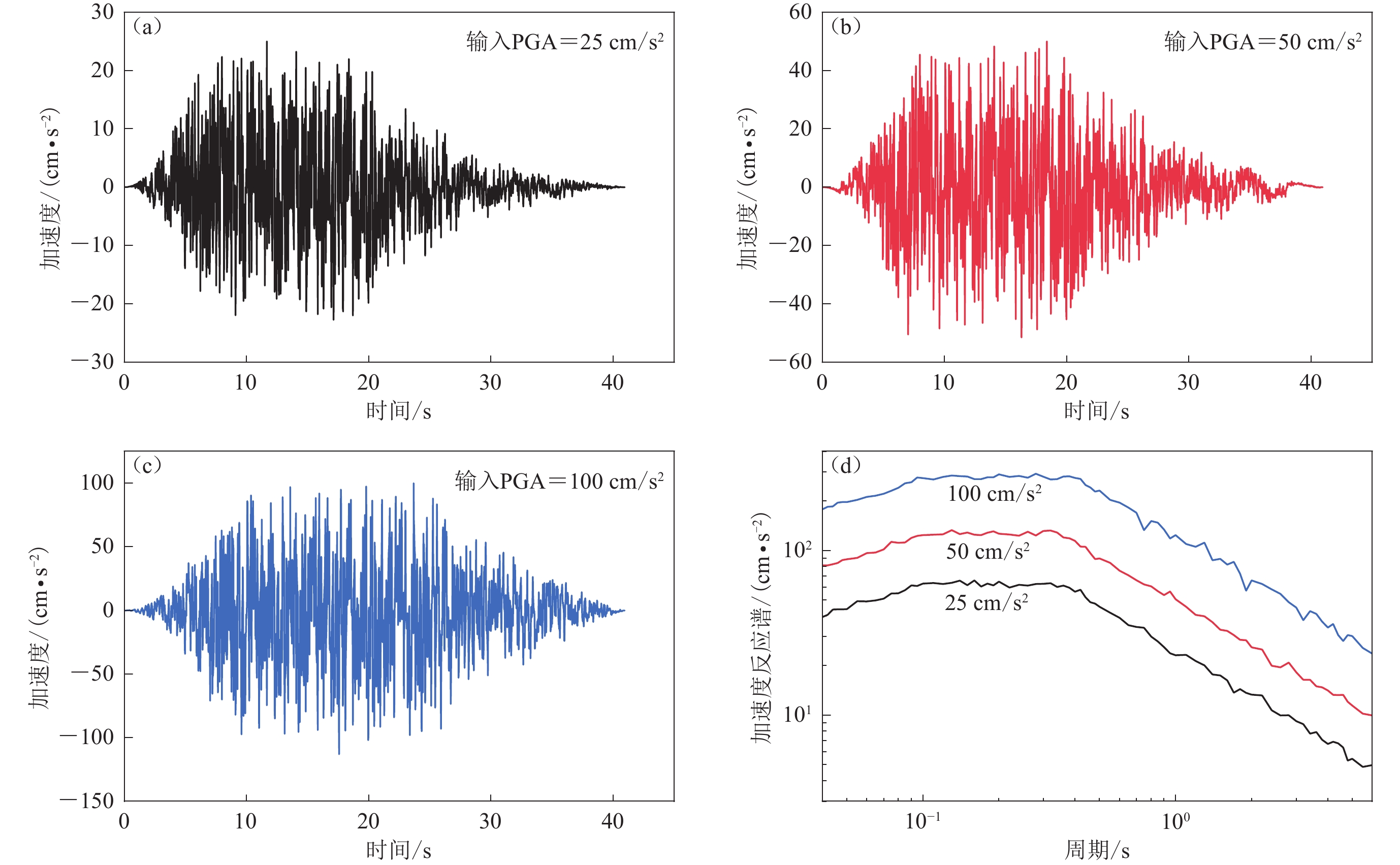
 下载:
下载:
